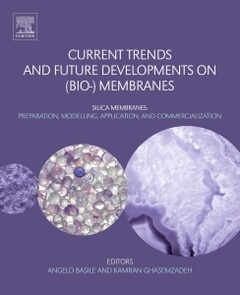Description
Current Trends and Future Developments on (Bio-) Membranes
Silica Membranes: Preparation, Modelling, Application, and Commercialization
Language: English
Subject for Current Trends and Future Developments on (Bio-) Membranes:
Support: Print on demand
Description
/li>Contents
/li>Readership
/li>Biography
/li>Comment
/li>
Current Trends and Future Developments on (Bio-) Membranes: Silica Membranes: Preparation, Modelling, Application, and Commercialization discusses one of the most promising inorganic membranes, namely silica membranes, and their different applications.
In the field of membrane separation technology, silica membranes play a key role in the future of the chemical industry as one of the most promising alternatives for separations at high temperatures and aggressive media.
This book details the latest research findings, along with the potential industrial applications of an area that has seen growing research activity on various type of membranes due to the necessity of gas separation and water treatment processes. Many industrial companies and academic centers will find immense interest in learning about the best strategies for carrying out these processes.
Introduction: Inorganic membranes roles in the industrial applications
Part A: Silica membrane preparation 1. Preparation of silica membranes by sol gel method 2. Preparation of silica membranes by CVD method 3. Preparation of silica membranes by CVI method
Part B: Theory analysis of silica membranes 4. Separation theory of silica membranes 5. Molecular dynamic (MD) simulation of silica membranes 6. Modeling of silica membranes
Part C: Application of silica membranes 7. Silica membranes application for water treatment 8. Silica membrane application for desalination process 9. Silica membrane application for pervaporation process 10. Silica membranes application for hydrogen separation 11. Silica membranes application for carbon dioxide separation 12. Silica membrane reactor
Part D: Challenges on commercializing the silica membranes 13. Hydrothermal improvement of silica membranes 14. Polarization in silica membranes 15. Silica membranes sealing in high temperatures
Membrane scientists involving in membrane preparation for various applications, chemical engineers and material scientists at undergraduate and particularly graduate students, post-doctoral researchers, and professors. Membrane fabrication companies
Angelo Basile, a Chemical Engineer with Ph.D. in Technical Physics, is author of hundreds of papers, books, chapter-books, and Special Issues in the field of Membrane Science and Technology, with also various Italian, European and worldwide patents. He is an Associate Editor of various int. journals (IJHE, APCEJ, etc), Editor-in-Chief of the Int. J. Membrane Sci. & Techn., and member of the Editorial Board of more 25 int. journals. Today Basile is working at General TAG, Via Mastri Ligornettesi n. 28, Ligornetto 6853 – Switzerland.
Kamran Ghasemzadeh is an associate professor in the Faculty of Chemical Engineering at the Urmia University of Technology, Iran where he has been a faculty member since 2014. From 2016-2018, also, he was nominated as head of chemical engineering faculty. On the other hand, from August 2018, he is nominated as director of UUT research center in Urmia university of technology. His research interests lie in the area of membrane and membrane reactor processes, ranging from modeling to design to implementation. In recent years, he has focused on study of inorganic membranes (graphene, silica and palladium membranes) performances for gas separation and water treatment from both aspects of experimental and modeling point of views. He has collaborated actively with researchers in several other disciplines of chemical engineering, particularly simulation of chemical processes by commercial Comsol Multiphysics, Fluent and Aspen Hysys software. Moreover, he has succeeded to publish more than seventy ISI and conference papers, two patents, seven books and also more than forty book chapters. Hence, Kamran has served on roughly twenty conference and workshop program committees.
- Reviews available methods for the characterization, preparation, and applications of silica membranes
- Includes new and emerging modeling methods
- Discusses silica membrane applications for hydrogen production and applications in CO2 capturing, water treatment, and pervaporation




